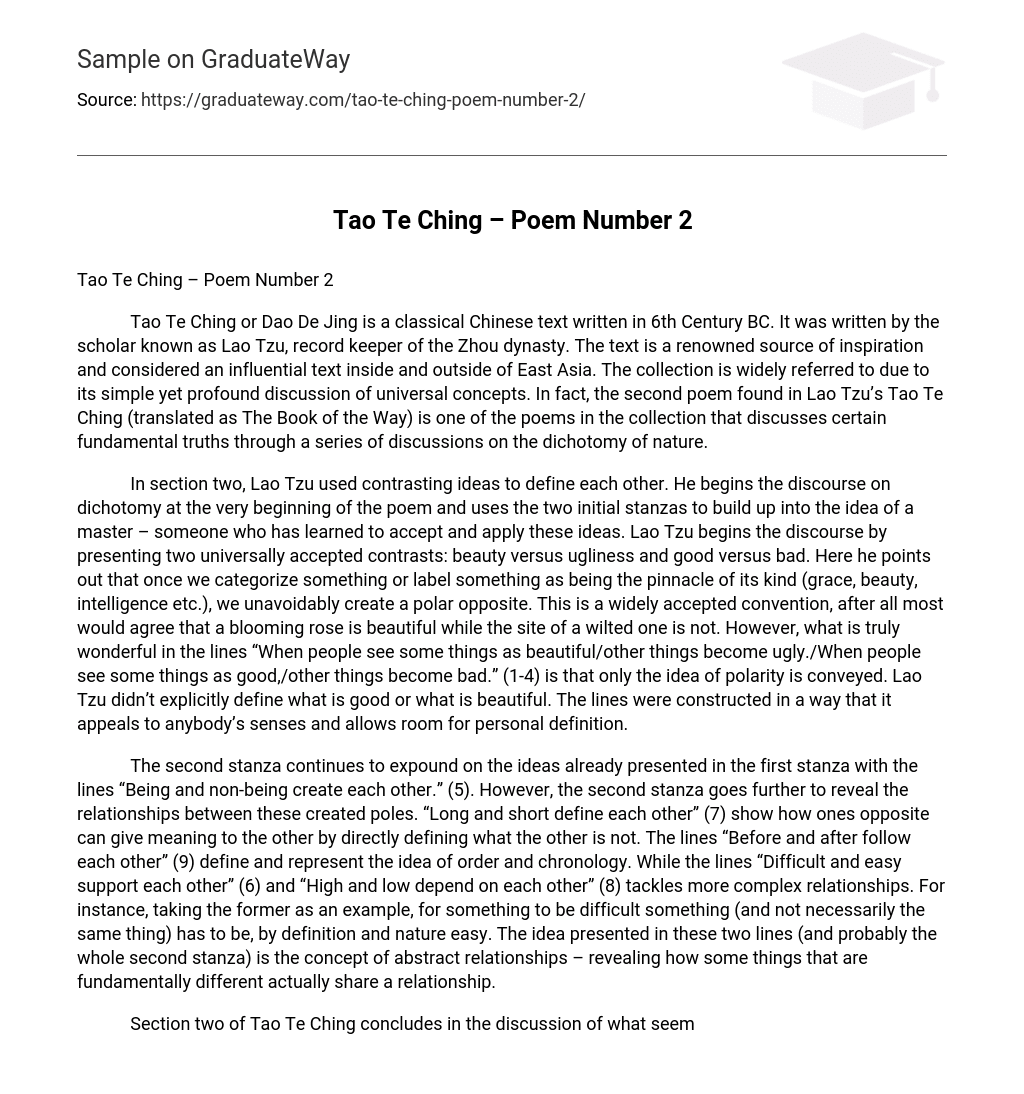Tao Te Ching or Dao De Jing is a classical Chinese text written in 6th Century BC. It was written by the scholar known as Lao Tzu, record keeper of the Zhou dynasty. The text is a renowned source of inspiration and considered an influential text inside and outside of East Asia. The collection is widely referred to due to its simple yet profound discussion of universal concepts. In fact, the second poem found in Lao Tzu’s Tao Te Ching (translated as The Book of the Way) is one of the poems in the collection that discusses certain fundamental truths through a series of discussions on the dichotomy of nature.
In section two, Lao Tzu used contrasting ideas to define each other. He begins the discourse on dichotomy at the very beginning of the poem and uses the two initial stanzas to build up into the idea of a master – someone who has learned to accept and apply these ideas. Lao Tzu begins the discourse by presenting two universally accepted contrasts: beauty versus ugliness and good versus bad. Here he points out that once we categorize something or label something as being the pinnacle of its kind (grace, beauty, intelligence etc.), we unavoidably create a polar opposite. This is a widely accepted convention, after all most would agree that a blooming rose is beautiful while the site of a wilted one is not. However, what is truly wonderful in the lines “When people see some things as beautiful/other things become ugly./When people see some things as good,/other things become bad.” (1-4) is that only the idea of polarity is conveyed. Lao Tzu didn’t explicitly define what is good or what is beautiful. The lines were constructed in a way that it appeals to anybody’s senses and allows room for personal definition.
The second stanza continues to expound on the ideas already presented in the first stanza with the lines “Being and non-being create each other.” (5). However, the second stanza goes further to reveal the relationships between these created poles. “Long and short define each other” (7) show how ones opposite can give meaning to the other by directly defining what the other is not. The lines “Before and after follow each other” (9) define and represent the idea of order and chronology. While the lines “Difficult and easy support each other” (6) and “High and low depend on each other” (8) tackles more complex relationships. For instance, taking the former as an example, for something to be difficult something (and not necessarily the same thing) has to be, by definition and nature easy. The idea presented in these two lines (and probably the whole second stanza) is the concept of abstract relationships – revealing how some things that are fundamentally different actually share a relationship.
Section two of Tao Te Ching concludes in the discussion of what seems to be Lao Tzu’s definition of a “master” using the two previous stanza’s ideas. Here, it is implied that the ideas previously presented – despite being universally accepted concepts – can be limiting to someone who tries to understand the world. Lao Tzu does not define a master as someone wise or intelligent since it would consequently label followers as dumb and inexperienced for that is not universally true. Instead he defines that a master “acts without doing anything/and teaches without saying anything” (11-12) implying that a true master can act through his thoughts and intentions and teach through example. He goes further to imply that a master is someone who is open [to ideas and events] and does not reserve judgment in the lines “Things arise and she lets them come;/things disappear and she lets them go./She has but doesn’t possess,/acts but doesn’t expect” (13-16). Lastly, Tzu also implies that a master does not quantify deeds and efforts, but rather accomplishes tasks the best possible way he/she knows thus making it that “When her work is done, she forgets it./That is why it lasts forever” (17-18).
I personally enjoyed reading the said selection. Lao Tzu’s writing is simple in construction and easily comprehended. The ideas he present are strikingly true even for the present, which is remarkable given that the text was written in the 6th Century BC. Reading section two of Tao Te Ching is an enlightening experience. Lao Tzu’s grasp on the dichotomy of things, how it defines our beliefs and how they could cloud our understanding is remarkable. Equally remarkable is how Lao Tzu discussed to full effect in 18 lines of text such an extensive concept which other philosophers and scholars often discuss in lengthy discourses. If anything, poem number two is definitely evidence as to why Lao Tzu’s Tao Te Ching is a renowned source of inspiration and considered an influential text inside and outside of East Asia.
Works Cited
Tzu, Lao. Tao Te Ching translated by Stephen Mitchell. Accessed 28 April 2009 <http://www.micro-foundry.com/tao/Tao.html>
1 When people see some things as beautiful,
2 other things become ugly.
3 When people see some things as good,
4 other things become bad.
5 Being and non-being create each other.
6 Difficult and easy support each other.
7 Long and short define each other.
8 High and low depend on each other.
9 Before and after follow each other.
10 Therefore the Master
11 acts without doing anything
12 and teaches without saying anything.
13 Things arise and she lets them come;
14 things disappear and she lets them go.
15 She has but doesnt possess,
16 acts but doesnt expect.
17 When her work is done, she forgets it.
18 That is why it lasts forever.





